The Architecture of William B. Langford : Making Waves in the Heartland
by Mark Chalfant
In this era of obscene power, the likes of which the game has never witnessed, why not strive to induce a little fun in the mix and at the same time present a true test of delicacy and accuracy by building short par threes ?
Ben Crenshaw, Masters of the Links, 1997
Taking golf design into the direction of more length is only a disservice to the ideals of strategic design inherited from the founders of golf course architecture. We are against such an approach finding it an undemocratic disservice to non-expert players, and unsatisfactory because it requires no imagination.
Tim Liddy and Tom Climo, Golf Architecture, 2003
The layouts of the Golden Age of golf course architecture and the men that created them have recently been receiving increasing attention. In the past few years biographical tributes and personal treatises of revered architects including Macdonald, Tillinghast, Travis, and Ross have appeared. This trend is certainly heartening but there are still some gifted architects whose contributions deserve to be better known. The golf courses created by Devereux Emmet, John VanKleek, Alex Findlay, Charles Banks,and William Langford spring to mind. The work of Banks, a protégé of Seth Raynor, punctuates hillsides around metropolitan New York. Unfortunately, the layouts built by ‘Steam Shovel’ Banks often get overlooked, perhaps due to the long shadow cast by A.W.Tillinghast in this region. By the way, Banks’ colorful nickname stemmed from his strong inclination for constructing many deep and nearly inescapable sand traps.
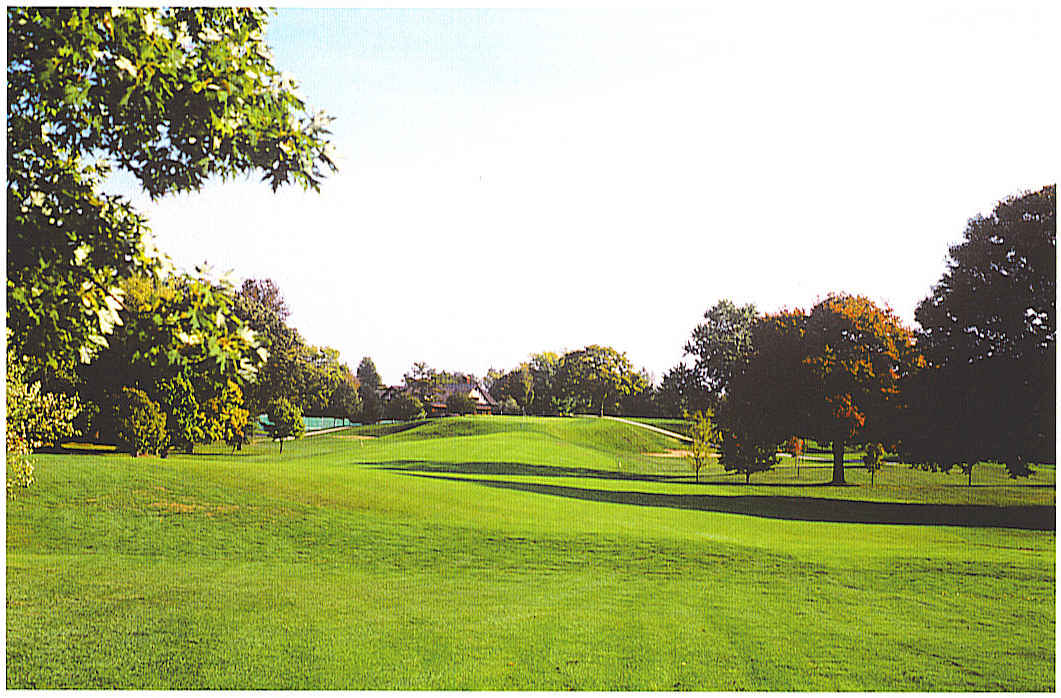
Harrison Hill's intriguing fifteenth rises to a steep plateau.
Far away from Banks’ home turf there was a firm known as Langford and Moreau that also demonstrated a flair for memorable bunkering. William Langford and Theodore Moreau were trained as engineers. Moreau, a graduate in civil engineering, let Langford handle the lion’s share of the design work. Moreau himself primarily oversaw the construction crew, which during the firm’s heyday, meant keeping tabs on close to eighty laborers.
William B. Langford, who hailed from Austin, Illinois, was born in 1887. During his childhood Langford suffered from polio but fortunately he fully recovered. A while later he took up golf (prescribed during rehabilitation) and excelled at thesport. In fact he ultimately played on Yale’s NCAA championship teams just after the turn of the century. Before long, Langford packed his bags for New York City where hestudied mining engineering at Columbia University. Apparently our forgotten master preferred working amidst pastoral landscapes rather than in dark mine shafts because by 1917 he had set up shop and designed golf courses in Illinois, Michigan, and Kansas.
During this formative period it is likely that Langford encountered a few courses by Tom Bendelow. Geoff Shackelford notes that Langford studied strategic concepts espoused by the influential writer John L. Low. However, William Langford soonwent on to develop a personal vision very much his own.
Langford’s body of work can be summed up in four phrases:
- Fun to play
- Full of variety
- Strategically interesting
- Routings that are often bold and expansive in scale
Some design motifs often evident include boldly contoured plateau greens defended by deep bunkers, and muscular par fours and par fives that tumble over fairways that heave like tumultuous ocean waves. Langford often came up with inspired routing plansbecause he had a definite knack for incorporating ravines, hillcrests, and valleys in a natural manner that was pleasing to the eye and challenging to play.
Snaking across the rolling prairie grasslands, the Mormon, Oregon, and Overland streched westward following the Missouri and the Platte Rivers. In their frenzy to reach the California gold fields, many overlooked Nebraska’s riches, but those who stayed soon realized that the soil was deep and willing, the water was plentiful so the promised land was right under their feet. Like their predecessors, those who currently stop in Nebraska find a friendly, giving place.
Nebraska Tour Book, 1995
Unlike Alister Mackenzie, Donald Ross and George Thomas, Langford never had the opportunity to craft a layout from dramatic oceanfront property or canyons in Bel Air but he can hold his head high for what he accomplished on inland terrain in America’s great plains and in the rust belt. Wakonda ( Iowa), Harrison Hills, Lawsonia, and Happy Hollow in Nebraska, are representative examples of Langford’s creativity.
Lawsonia presents superb variety ranging from the volcanic seventh (155 yards) to the captivating thirteenth (560 yards). This charming course, located in Green Lake, Wisconsin features many spectacular driving holes where the tee shot must elude cavernous fairway bunkers that chew into the undulating fairways. Lawsonia also tests your nerves with vigorous putting examinations via greens that are complicated by full bodied swales and terraces. The three shotters here, some of which are Herculean in scale, traverse the gently rolling property gracefully.
The dramatic quartet of long holes at Wakonda, however, are just as fun to tackle as the ensemble at Lawsonia. Indeed, it was not until over a generation later when Pete Dye burst onto the scene that any golf course architect came close to Langford’s virtuosity in molding the lay of the land into such brilliant and strategic long holes. At Wakonda the strech from 12 through 15 (4 5 3 5) is especially memorable for its parkland elegance, topography, and its subtle quirkiness. In fact, The Confidential Guide has sung praises regarding the roller coaster (500 yards) fifteenth, characterizing it as extremely sporty.
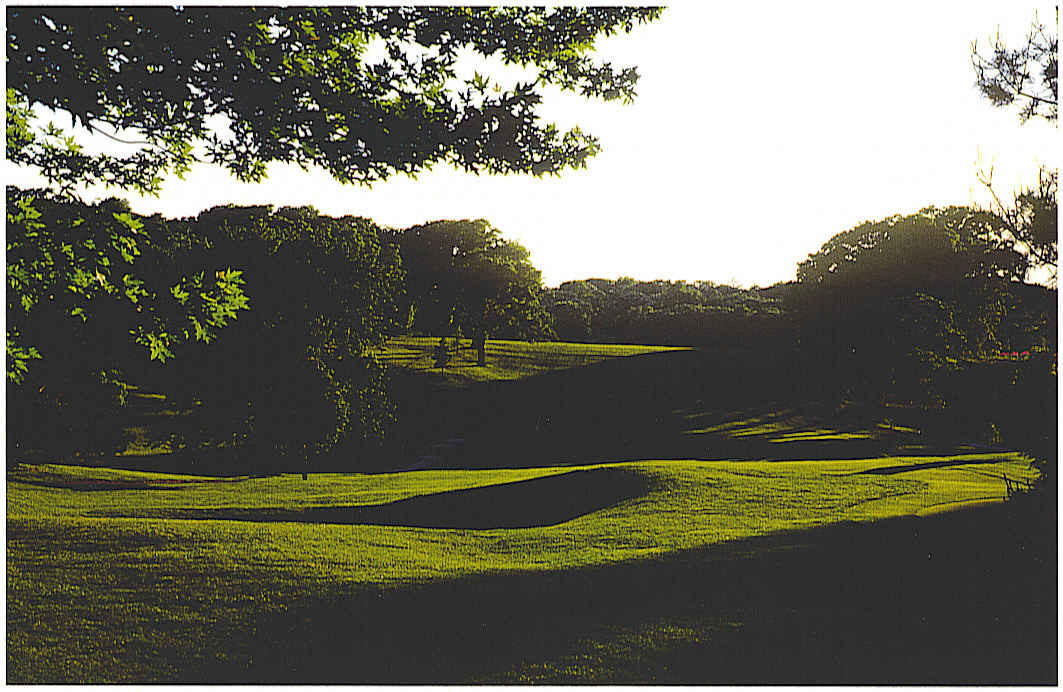
Looking back at Wakonda's long yet graceful fifth. Deane Beman edged R.H. Sikes at this Iowa masterpiece to capture his seocnd USGA Amateur title in 1963.
Like Donald Ross, many architects felt green contours had to be shaped by hand. Bill Langford painstakingly staked out the elevation changes of his greens and bunkers.
Cornish and Whitten, The Architects of Golf, 1993
Before covering some other examples of Langford’s work we will briefly mention a few of his other pursuits. Langford wrote about both the strategy and the business sideof golf. In the twenties, he wrote passionately about the need for six hole golf courses to accommodate the budget and the schedule of busy working men.
Although this idea never caught on, our Midwest visionary refused to lose touch with the needs of common folk, as he operated several daily fee courses in the state of Illinois. Serving for many years on the USGA Public Links Committee was yet another contribution he made to the game. But certainly his most towering m accomplishment was his architectural practice. The fruits of this practice were a superb fusion of art and strategy. Langford expressed part of this credo in the following statement in a 1919 essay :
Hazards should be placed so that any player can avoid them if he gauges his ability correctly, so that these obstacles will make every man’s game more interesting, no matter what class player he is.
Part of Langford’s artistry derives from his meticulous construction techniques in the pre-bulldozer era that he flourished in. In many cases, his green complexes look more naturalistic (less engineered) than those of Raynor or Banks.This occurred because Moreau told their steam shovel operator to let the scraps fall where they may. Then highly experienced crew members would patiently finish the hazard’s wall and floor via hand raking. As a result, these bunker walls and the nearby green surrounds ended up with a more curvilinear silhouette, almost graceful, in comparison to many of Charles Bank’s rather rectilinear traps. Tim Liddy has explained that the technical term for this shaping feature is called ‘ the angle of repose’.
Liddy, who happens to be one of Pete Dye’s several fine proteges, professes an admiration for Langford and Moreau’s bold yet graceful green complexes. He also greatly appreciates their daring sense of scale. Liddy recently chuckled while saying: I could fit my house in one or two of those huge bunkers that Langford built at his neat course in Culver, Indiana.
By the time Langford passed away, a few heartbeats short of his ninetieth birthday, his resume included over 200 courses. Nevertheless, the team of Langford and Moreau are not household names even among avid golfers. Yet the handful of connoisseurs who have been wise enough to venture off the beaten path in search of Langford’s appealing courses are pleasantly surprised. For example, the veteran sports writer Dan Jenkins chose Wakonda’s third hole as one of America’s finest two shotters following histranscontinental search for Sports Illustrated in the 1960s. Among contemporary observers Ron Whitten and Daniel Wexler admire the firm. Many golf course architectsincluding Jeff Brauer, Mike DeVries, Tim Liddy, and Ron Forse have enthusiastically voiced positive sentiments about courses by this often underappreciated design team.
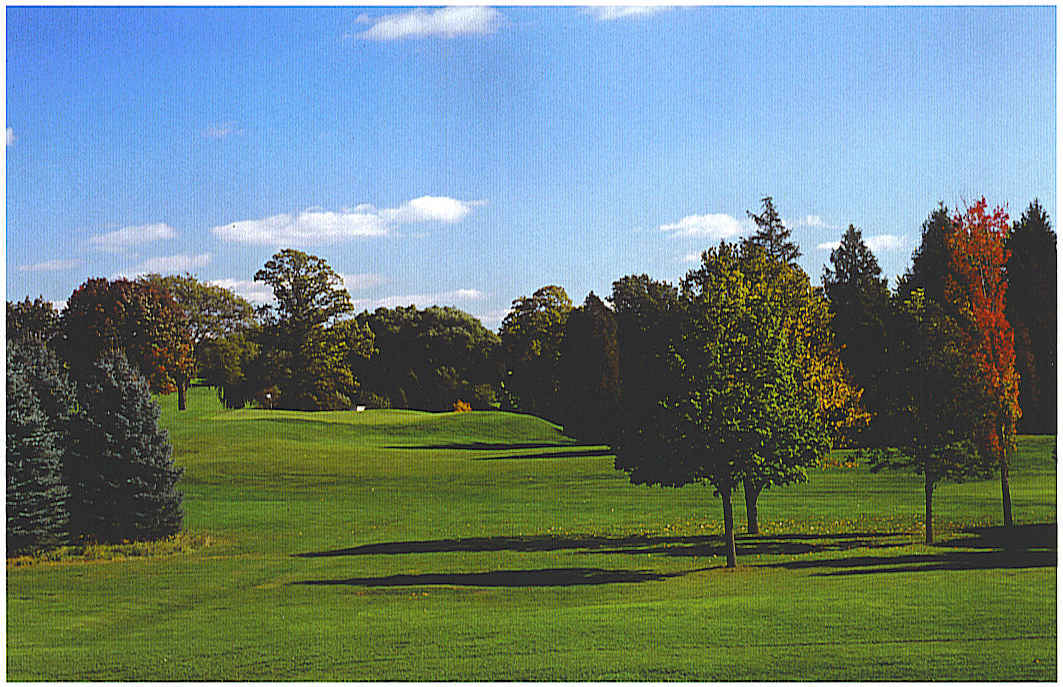
Tommy Armour fought off Horton Smith's challenge to prevail in the 1929 Western Open at Ozaukee. The naturalistic lines evident in this green complex at fourteen exemplify Langford and Moreau's refined expertise with regard to artistic construction.
Based on his sensitive work at Ozuakee, Long Vue, Golden Valley, and Newport, Ron Forse should be awarded the Nobel Prize for restoration of Golden Age golf courses. Forse is an ardent admirer of Langford and Moreau’s body of work.
Forse cautions against stereotyping Langford’s work, noting that the steep pushed up green complexes that vitalize West Bend contrast with the restrained grading that was utilized at Portage near Akron. Forse also points out that the quirky bunkering scheme on the level plot at Portage is mildly reminiscent of the creative bunkering sometimes built by Donald Ross during his early phase.
Many of Langford’s most compelling holes are draped over hilly, almost Himalayan terrain. However this master architect’s work at Skokie, Key West, and Happy Hollow validate Ron Forse’s assertion regarding Langford & Moreau’s versatility.
For instance, at the rather level Skokie property, they created some inspiring golf holes by thoughtfully placed bunkering. The eleventh (560 yards) embodies this design strength. The path of the fairway on this par five takes on a soft S shape that skirts several bunkers which are notable for their strategic positioning. In most cases, this hazardous avenue forces the golfer to carefully shape the ball in two different directions on the same hole.
The land at Key West (NLE) on Stock Island, Florida was flatter than a tired omelette. Daniel Wexler’s research shows that Langford overcame this drawback by featuring no less than ten sternly-bunkered doglegs that tended to reward only those who practiced nimble shotmaking and intelligent course management. Happy Hollow challenged Langford with an even more intricate puzzle to solve.
Happy Hollow, which is on the western edge of Omaha, Nebraska, is an intriguing land form. The memorable topography on the front nine ( sharp elevation changes ) contrasts with the quieter middle portion of the incoming nine ( subtly graded fairways ). However, it would be a mistake to dismiss Happy Hollow as a fragmented golf course with two personalities. This is primarily because Langford spent great care incrafting each and every green complex. The lovely contours on all eighteen greens, gentle by Langford’s usual standard, lend a sense of coherence that serves to integrate the overall composition.
The spice of golf, as of life, lies in variety.
Robert Hunter,The Links, 1926
To invoke a musical analogy Langford’s work isn’t really about crashing cymbals and loud horns. Nevertheless, there is a symphonic quality about his gift forchanges of pace which add so much character to his routings. Like a seasoned composer, Langford consistently knows just the right moment to ascend and retreat from crescendos. Indeed there seem to be shifts of tone in his work where fortissimo (forceful) complements, or plays off of piano (soft). For better or worse sometimes golf courses have a musical structure. Unfortunately playing on some courses is like experiencing a poorly conceived opera that is neither tragic or comic but simply long and monotonous.
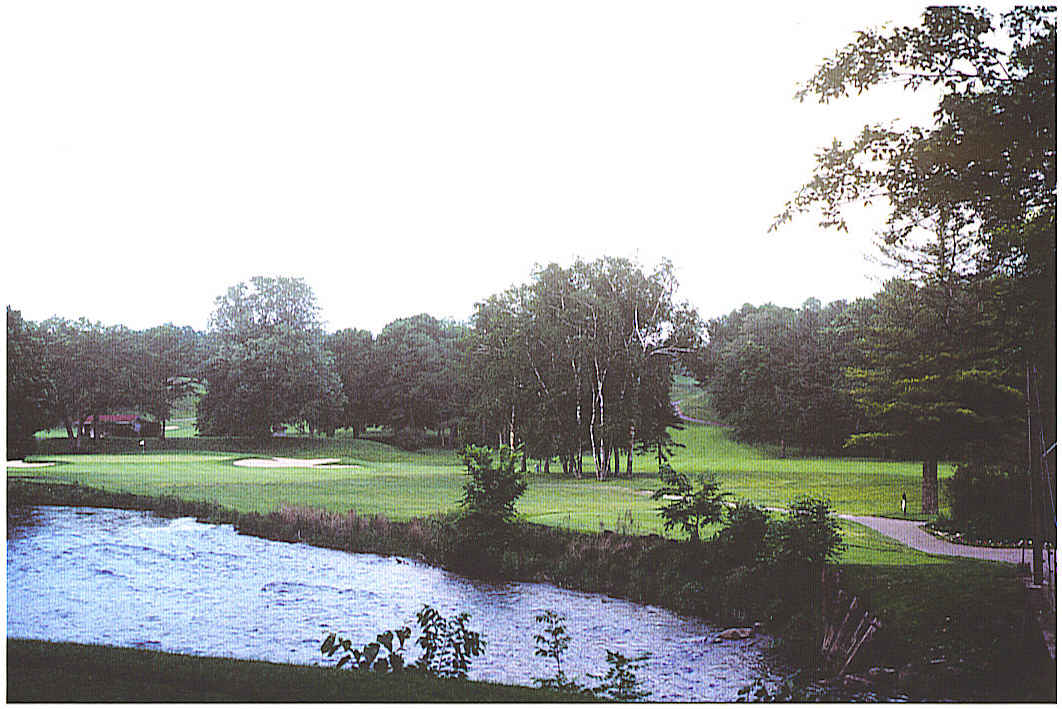
The peaceful short thirteenth at Blythefield, the Michigan site of Arnold Palmer's 1961 triumph in the Western Open. Palmer won five other events that year including the British Open.
Langford believed that enjoyable golf involved much more thansuffering through a ‘championship course’ composed of numerous backbreaking two-shotters and par fives with an absence of strategic interest. This unsung master devoted equal energy to designing par 3s and par5s that are infused with character.( we won’t mention the F-word here but there’s a well known tournament venue in Akron that is the antithesis of Langfordian architecture). Langford used tandems where rugged three shotters are followed by one shotters. The latter were often tiny postage stamps that added some fun like Crenshaw alluded to earlier. Langford also liked to include sporty short par fours as a foil to longer ones. Diversity prevails.
Moreover, Langford often refused to embrace the formulaic par 72 configuration. Instead, to enhance variety he often built five par threes and sometimes even went with five three shot holes. This creative tendency where the land, not man’s hand, guides routing decisions, has elevated the work of current architects including Gil Hanse, Tim Liddy, Dave Axland, Mike DeVries and Bill Coore. Hanse, writing in the Masters of the Links, stresses the importance a designer embracing their site and toilinghard in order to’squeeze every ounce of character, strategy, and natural interest out of the landscape.Unless the golfer has been sipping way too much from his flask, he should be noticing both character and strategy within about fifteen minutes on most Langford golf courses. Other golf course architects and writers have words of interest.
Less than a generation ago there was precious little serious writing about the subject that devotees of classic architecture care so passionately about. Happily, many people such as Daniel Wexler, Geoff Shackelford, Bradley Klein, Paul Daley, James Finegan, and George Bahto have stepped up to create a rich body of literature that is meticulously researched and beautifully written. Wexler’s books, Missing Links and Lost Links are so valuable because they give us a vivid glimpse of fascinating courses, such as Langford’s Acacia, Emmet’s Grassy Sprain, and Alison’s breathtaking Timber Point that sadly are no longer in existence. The architectural legacy of both Devereux Emmet and William Langford made a lasting impression on Daniel Wexler. Wexler has stated that he was quite impressed with the ‘depth as well as the strategy’ apparent in so many courses designed by Emmet and by Langford.
It is not the purpose of this essay to scientifically trace the sources of Langford’s fertile imagination or his possible influence on subsequent architects. Yet it seems rather clear that his tendencies and thematic concerns often bear striking similarities to gifted disciples of Charles Blair Macdonald namely, Charles Banks and Seth Raynor. Large pushed up greens that are peppered with intense undulation and also defended by deep bunkers with steep walls are shared motifs. However, in contrast to Banks, Langford rarely relied, on template holes derived from acclaimed paradigms imported from the British Isles or France. Occasionally, he seemed to mildly allude to the Biarritz or Redan. For example, the fine 14th at Ozaukee (Redan) and the 12th at Lawsonia (Biarritz).
It should be mentioned that the Lawsonia Biarritz has less of a frontal orientation than either Raynor’s version at Fox Chapel or Banks 12th at Tamarack do. In sum, the Lawsonia hole seems more naturalistic than the other two holes because edges of its putting surface melt into the surrounds more gently.
Lawsonia is remarkable. The routing is absolutely amazing, especially the six hole strech from 9 through 14 where there’s not a single par four. You know I saw Pete’s Blackwolf River course earlier that same day. It’s excellent too. I definitely admire how Pete Dye takes chances. But Langford’s design at Lawsonia is very bold and very strategic. And so fun to play !! That was really a great day but Lawsonia is the course that really sticks in my memory.
Mike DeVries, conversation with the author, 2003
Sometimes the bold and visionary golf architecture of Langford, Raynor, and Banks the hand of man is present. The same holds true for the brilliant designs of Pete and Alice Dye. Pete Dye has taken note of West Bend and characterizes it as worth a detour.
Tim Liddy has noted that the Dye family played many rounds together at Langford’s boldly- shaped Maxincuckee course in northern Indiana. Liddy, a promising architect who studied under Dye suggests that these features probably provided a frame of reference that may have laid the seed for Pete and Alice’s monumental sense of scale. At any rate, there seems to be common mind set among individuals such as Emmet, Banks, Findlay, Doak, Langford, Maxwell, Dye, and Hanse.
Such a common stylistic thread revolves around what some dismiss as quirk whilesome others might applaud it as artistic imagination, stemming partially from listening to the land. The land is a point of departure. But sometimes it’s necessary to move lot of dirt to increase strategic options or even to make the end result look like little dirt was moved at all. Applebrook , by Hanse& Hine, is a Pennsylvania course that epitomizes this skill.
I prefer to think of the eight masters mentioned above as architects with a sense of humor. They certainly want the eighteen hole journey to be memorable and reasonablychallenging, but most of all, these gifted artists want us to have fun. When I’ve embarked on pilgrimages out to the great plains to play Langford’s work I am often reminded of Forsgate, Tamarack and Whippoorwill which are three boldly undulating masterpieces created by Steam Shovel Banks. Are Banks and the other men over the top ? Not in my mind. Are they artistic visionaries with a sense of humor? In my opinion, yes they are.
Finally, my friends often ask: Mark what’s your favorite Langford course? That’s hard to choose but Harrison Hills, in Attica, Indiana is near the top of the list. The last four holes there are a virtual textbook of beautifully realized Golden Age design features. Tom Doak also thinks highly of this course terming it as ‘ wild, fun, and challenging.’ He called these attributes, which are so plentiful at Harrison Hills , ‘what golf was invented to be’. When it comes to traveling, Doak makes Marco Polo seem like a couch potato. And anyone who has been lucky enough to tee it up at Pacific Dunes know that this architect’s words should be taken seriously. Moreover, he contends that Harrison Hills, along with masterpieces like Cruden Bay and Whitinsville, are among the most fun to play anywhere in the entire world of golf .So it seems Langford’s creation, tucked away in a quiet village that hugs the Wabash River, is in very good company.
Langford did so many things well including: excellent construction, artistic drawings of his greens, and imaginative routings. He was one of the best !
Tim Liddy, 2003
In the next few years I hope to experience Clovernook, Pasatiempo, Swinley Forest, and Pennard. But first things first. Before flying to either California or across the Atlantic Ocean, I need to get one more road trip out of my system. It will occur next July. I will pick up a shiny red compact in Shaker Heights, Ohio to begin a pilgrimage way up north towards Lake Superior. I plan to play Greywalls, a scenic and strategic golf course recently designed by Mike DeVries in Marquette, Michigan. But of course, I will spend plenty of time across the street to study the nine sporty holes crafted by William Langford in 1927. Much like Coore, Forse, and Langford, DeVries fully realizes that creating vibrant sequences of holes by embracing the land’s natural ground features is the foundation of memorable golf course architecture.
In this area of Michigan’s Upper Peninsula there are some lovely views of Lake Superior from commanding bluffs accented by tall hemlock and birch trees. I am almost sure that my long drive will be worth the effort, even if it’s misty outside. Partially, because the people there are likely to be friendly and giving. But most of all, because I will see another design by the unsung architect who studied mining at Columbia University. And that man, William Langford, has never failed me.
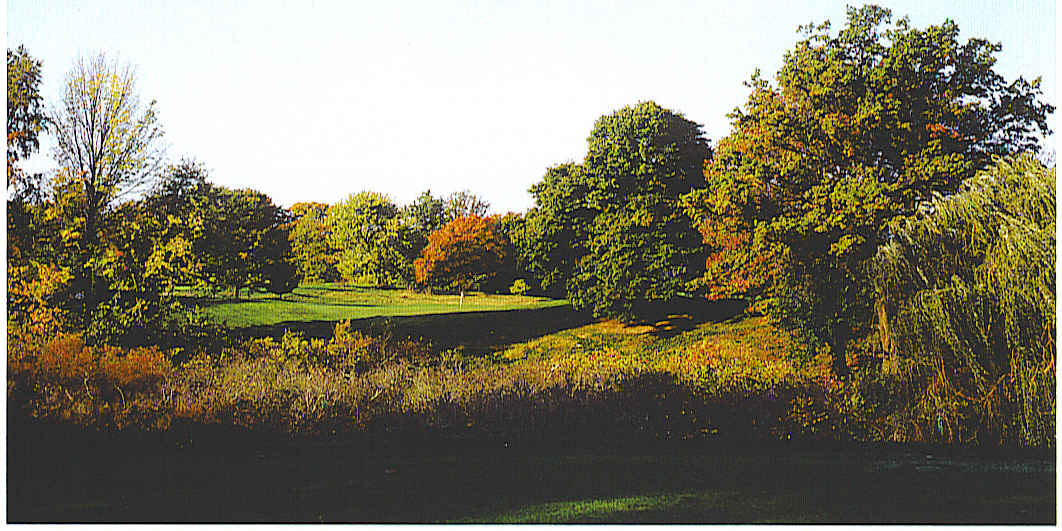
The pilgrim who travels to Harrison Hills will long remember both the challenging holes and the natural beauty of their surroundings.
The true golf expert should study botany, geology, and particularly agricultural chemistry. But more importantly he must possess what might be termed an artistic imagination.
Alister Mackenzie, Golf Architecture, 1920
The End








